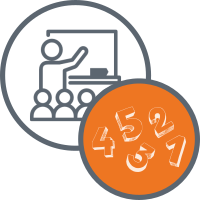You are here
Effective Mathematics Teaching Practice 5: Pose Purposeful Questions
Instructional Support Menu
Pose Purposeful Questions
Questioning is one of the most difficult teaching skills and one where our powers of improvisation regularly fail us. Mathematics teachers too often fall into the traditional routine of initiating a student response with a question, getting a simple response from a student, and then evaluating the student’s response. This pattern is so ubiquitous it’s simply known as the I-R-E pattern (Mehan, 1979), and in many mathematics classrooms it sounds like this:
Teacher: Devin, what did you get for Question 17?
Devin: Is it x = 27.5?
Teacher: That’s correct.
One quick way to notice such patterns is that students will rarely say a second sentence in response to a teacher. Posing purposeful questions in the mathematics classroom must go beyond simple recall questions and dead-end questioning patterns. Instead of simply funneling students towards reaching a predetermined conclusion, a teacher should ask focusing questions that press students to communicate their thinking completely and clearly and make students link their ideas to those of classmates or to previously learned material (Boston, Canela, & Dixon, 2019; Herbel-Eisenmann & Breyfogle, 2005). Shifting to become a better questioner is not easy, and will likely require careful planning of some questions in advance and reflection to see if those questions are achieving their desired effects.
Effective teaching of mathematics uses purposeful questions to assess and advance students’ reasoning and sense making about important mathematical ideas and relationships.
-NCTM (2014), p. 29
The Practice in Action
One of the ways NCTM (2014, p. 41) summarizes the practice of pose purposeful questions is by describing a set of actions expected of teachers and students that indicate engagement in this teaching practice.
Caution! Don't over-estimate your own understanding based on these brief descriptions of teaching practice. Professional educators should dig more deeply into NCTM's resources, join study groups and professional networks, and seek out professional development and coaching to ensure high-quality engagement in the practice.
What are teachers doing?
- Advancing student understanding by asking questions that build on, but do not take over or funnel, student thinking.
- Making certain to ask questions that go beyond gathering information to probing thinking and requiring explanation and justification.
- Asking intentional questions that make the mathematics more visible and accessible for student examination and discussion.
- Allowing sufficient wait time so that more students can formulate and offer responses.
What are students doing?
- Expecting to be asked to explain, clarify, and elaborate on their thinking.
- Thinking carefully about how to present their responses to questions clearly, without rushing to respond quickly.
- Reflecting on and justifying their reasoning, not simply providing answers.
- Listening to, commenting on, and questioning the contributions of their classmates.
Resources
- Principles to Action: Ensuring Mathematical Success for All (NCTM, 2014, pp. 35-41)
- Taking Action: Implementing Effective Mathematics Teaching Practices in K-Grade 5 (NCTM, 2017, pp. 97-118)
- Taking Action: Implementing Effective Mathematics Teaching Practices in Grades 6-8 (NCTM, 2017, pp. 77-97)
- Taking Action: Implementing Effective Mathematics Teaching Practices in Grades 9-12 (NCTM, 2017, pp. 71-97)
- Enhancing Classroom Practice with Research behind Principles to Actions (NCTM, 2017, pp. 49-60)
- Making Sense of Mathematics for Teaching to Inform Instructional Quality (Boston, Candela, & Dixon, 2019)
- Questioning Our Patterns of Questioning (Herbel-Eisenmann & Breyfogle, 2005)




Connect With Us





